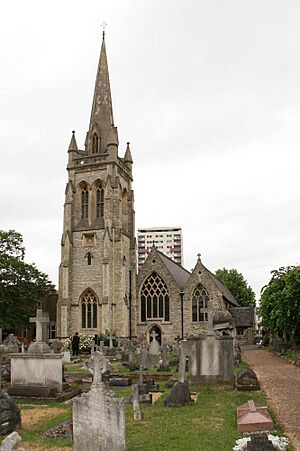St Thomas of Canterbury Church, Fulham facts for kids
Quick facts for kids St Thomas of Canterbury Church |
|
|---|---|

St Thomas of Canterbury Church, Rylston Road
|
|
| 51°28′54″N 0°12′21″W / 51.48168°N 0.20597°W | |
| Location | Fulham, London SW6 |
| Country | United Kingdom |
| Denomination | Roman Catholic |
| Religious order | Diocesan |
| Website | https://stthomasfulham.com/ |
| History | |
| Former name(s) | St Thomas à Becket of Canterbury |
| Status | Active |
| Founded | 1847 |
| Founder(s) | Mrs Elizabeth Bowden |
| Dedication | St Thomas of Canterbury |
| Consecrated | 1847 |
| Architecture | |
| Functional status | Parish church |
| Heritage designation | Grade II* |
| Designated | 1970 |
| Architect(s) | Augustus Pugin |
| Style | Gothic Revival |
| Completed | 1848 |
| Administration | |
| Archdiocese | Westminster |
St Thomas of Canterbury Church, also known as St Thomas's, Rylston Road, is a Catholic church in Fulham, central London. It was designed in 1847 by a famous architect named Augustus Pugin. The church is known for its beautiful Gothic Revival style. This means it looks like buildings from the Middle Ages.
The church is a very important historical building. It is listed as Grade II* listed by Historic England. This special listing means it is a particularly important building. It stands at 60 Rylston Road, Fulham, and is part of a group of buildings designed by Pugin. These include the church, its presbytery (where the priests live), and a primary school.
Contents
The Story of St Thomas's Church
Why Was the Church Built?
St Thomas of Canterbury Church was started in 1847. It was built in memory of J. W. Bowden by his wife, Elizabeth Bowden. She wanted to create a special place for worship. This church is the only complete church in London designed entirely by Augustus Pugin.
A New Place for Catholics in Fulham
Before St Thomas's, there hadn't been a purpose-built Catholic church in Fulham since the English Reformation. That was a long time ago! The first stone of the church was laid in 1847. It was opened in 1848 by John Henry Newman. The church was built to serve the many Catholic families who worked in the local market gardens.
What Does the Church Look Like Inside?
Pugin designed the church in a style called "Decorated English Gothic." This style was popular in the late 1200s and early 1300s. The church has beautiful details inside. For example, it has special carved altars called reredoses in its side chapels. These are made from a type of stone called Caen stone. The church also has amazing stained glass windows.
The church has a tall tower and a pointed steeple. It reaches 142 feet high! This tower faces a small cemetery that opened in 1849.
The Church Cemetery
Who is Buried Here?
The cemetery at St Thomas's Church is a historic place. Many interesting people are buried there. For example, Sir Thomas Henry, who was a chief judge in London, is buried here. Also, Lord Alexander Gordon-Lennox, a politician, and his wife Emily are laid to rest in the cemetery.
Mrs Elizabeth Bowden, who helped found the church and school, is also buried here with her daughter. Another notable person is Joseph Aloysius Hansom. He designed many churches and even invented the Hansom cab, a type of horse-drawn carriage.
Other Important Burials
Other architects like Herbert Gribble and Joseph John Scoles are also buried in the cemetery. Several mayors of Fulham are here too. Interestingly, three great-grandchildren of the famous writer Charles Dickens were buried here as babies.
War Memorials
The cemetery also honors those who served their country. Three officers who died in World War I are buried here. There is also a special war memorial. It lists the names of 59 people from the church who died in the First World War. This war memorial and some tombstones in the cemetery are also Grade II listed for their historical importance.



